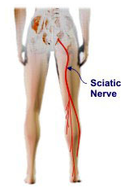Sciatica

Sciatica is the name for a syndrome which is characterised by pain that radiates along the path of the sciatic nerve. The sciatic nerve is the longest and largest nerve in the body — it is as thick as one of your fingers where it arises in the lower spine. It then travels from your lower back through your hip and buttock and down your leg where it divides into two branches at the knee. Each leg has its own sciatic nerve. Sciatica is not a diagnosis but is rather a description of the pain, therefore warranting further investigation to determine the cause of the pain.
There are several possible causes of sciatica:
Compression of the sciatic nerve as it travels through the piriformis muscle in the buttock. This is called piriformis syndrome.
A herniated disk. Herniate means bulge or stick out. Intervertebral disks are the spongy disks that form a cushion between the vertebrae of the spine. The disks have a strong outer layer made of cartilage, with a soft gelatinous centre that acts as a shock absorber. If the outer layer of the disk becomes weak, through age or injury, the soft centre can bulge out through the weakness — this is often what’s known as a herniated or ruptured disk. If any of the 5 pairs of nerve roots that form the origin of the sciatic nerve are compressed in the spine by a ruptured disk they can give rise to pain down the sciatic nerve. Not only does a herniated disk press on the nerve root, but chemicals leaking from the soft centre of the disk irritate the nerve root, causing inflammation.
Spondylolisthesis is where one vertebra slips forward over the vertebra below it. This distorts the spinal canal and can result in the nerve roots of the sciatic nerve being compressed. In adults, the fourth and fifth lumbar vertebrae (L4 and L5) are most commonly affected, with the L4 vertebra moving forward on the L5 vertebra. Spondylolisthesis usually results from degenerative diseases of the spine, such as arthritis.
Other possible causes include pregnancy and degenerative spinal disorders such as canal stenosis.
There are several possible causes of sciatica:
Compression of the sciatic nerve as it travels through the piriformis muscle in the buttock. This is called piriformis syndrome.
A herniated disk. Herniate means bulge or stick out. Intervertebral disks are the spongy disks that form a cushion between the vertebrae of the spine. The disks have a strong outer layer made of cartilage, with a soft gelatinous centre that acts as a shock absorber. If the outer layer of the disk becomes weak, through age or injury, the soft centre can bulge out through the weakness — this is often what’s known as a herniated or ruptured disk. If any of the 5 pairs of nerve roots that form the origin of the sciatic nerve are compressed in the spine by a ruptured disk they can give rise to pain down the sciatic nerve. Not only does a herniated disk press on the nerve root, but chemicals leaking from the soft centre of the disk irritate the nerve root, causing inflammation.
Spondylolisthesis is where one vertebra slips forward over the vertebra below it. This distorts the spinal canal and can result in the nerve roots of the sciatic nerve being compressed. In adults, the fourth and fifth lumbar vertebrae (L4 and L5) are most commonly affected, with the L4 vertebra moving forward on the L5 vertebra. Spondylolisthesis usually results from degenerative diseases of the spine, such as arthritis.
Other possible causes include pregnancy and degenerative spinal disorders such as canal stenosis.